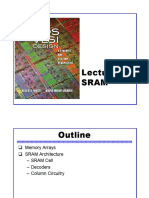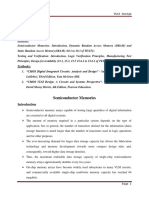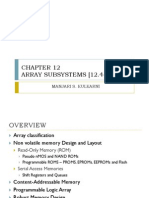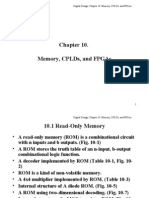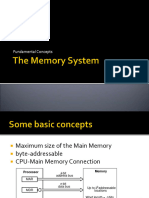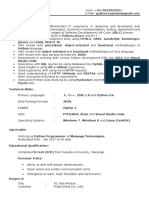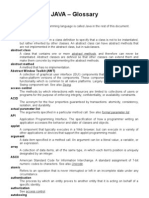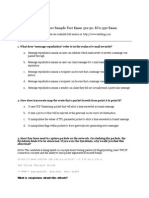8-
CHAPTER
Array Subsystems
VLSI Design
Chih-Cheng Hsieh
�Outline
1.
2.
3.
4.
5.
6.
VLSI Design
8- 2
SRAM
DRAM
Read-Only Memory (ROM)
Serial Access Memory
Content-Addressable Memory
Programmable Logic Array
Chih-Cheng Hsieh
�Memory Arrays
8- 3
Memory Arrays
Random Access Memory
Read/Write Memory
(RAM)
(Volatile)
Static RAM
(SRAM)
Dynamic RAM
(DRAM)
Mask ROM
Programmable
ROM
(PROM)
VLSI Design
Content Addressable Memory
(CAM)
Serial Access Memory
Read Only Memory
(ROM)
(Nonvolatile)
Shift Registers
Serial In
Parallel Out
(SIPO)
Erasable
Programmable
ROM
(EPROM)
Queues
Parallel In
Serial Out
(PISO)
Electrically
Erasable
Programmable
ROM
(EEPROM)
First In
First Out
(FIFO)
Last In
First Out
(LIFO)
Flash ROM
Chih-Cheng Hsieh
�Array Architecture
8- 4
2n words of 2m bits each
If n >> m, fold by 2k into fewer rows of more columns
wordline
s
bitline conditioning
bitlines
row decoder
memory cells:
2n-k rows x
2m+k columns
n-k
column
circuitry
k
n
column
decoder
2m bits
Good regularity easy to design
Very high density if good cells are used
VLSI Design
Chih-Cheng Hsieh
�SRAM Architecture
8- 5
SRAM Cell
Decoders
Column Circuitry
Multiple Ports
VLSI Design
Chih-Cheng Hsieh
�12T SRAM Cell
8- 6
Basic building block: SRAM Cell
Holds one bit of information, like a latch
Must be read and written
12-transistor (12T) SRAM cell
Use a simple latch connected to bitline
46 x 75 l unit cell
bit
write
write_b
read
read_b
VLSI Design
Chih-Cheng Hsieh
�6T SRAM Cell
8- 7
Cell size accounts for most of array size
Reduce cell size at expense of complexity
6T SRAM Cell
Used in most commercial chips
Data stored in cross-coupled inverters
Read:
Precharge bit, bit_b
Raise wordline
bit
bit_b
word
Write:
Drive data onto bit, bit_b
Raise wordline
VLSI Design
Chih-Cheng Hsieh
�SRAM Read
Precharge both bitlines high
word
Then turn on wordline
One of the two bitlines will
be pulled down by the cell
Ex: A = 0, A_b = 1
bit discharges, bit_b stays high
But A bumps up slightly
Read stability
A must not flip
N1 >> N2
(N1 is stronger than N2)
VLSI Design
8- 8
bit_b
bit
P1 P2
N2
A
N4
A_b
N1 N3
A_b
bit_b
1.5
1.0
bit
word
0.5
A
0.0
0
100
200
300
400
500
600
time (ps)
Chih-Cheng Hsieh
�SRAM Write
8- 9
Drive one bitline high, the other low
bit
Then turn on wordline
word
Bitlines overpower cell with
N2
new value
A
Ex: A = 0, A_b = 1, bit = 1,
bit_b = 0
Force A_b low, then A rises high
Writability
Must overpower feedback
inverter
N4 >> P2
bit_b
P1 P2
N4
A_b
N1 N3
A_b
A
1.5
bit_b
1.0
0.5
word
0.0
0
100
200
300
400
500
600
700
time (ps)
VLSI Design
Chih-Cheng Hsieh
�SRAM Column Example
Read
8- 10
Write
Bitline Conditioning
Bitline Conditioning
More
Cells
More
Cells
word_q1
word_q1
bit_v1f
word_q1
out_b_v1r
VLSI Design
bit_v1f
bit_b_v1f
bit_v1f
SRAM Cell
SRAM Cell
bit_b_v1f
out_v1r
write_q1
H
out_v1r
data_s1
Chih-Cheng Hsieh
�SRAM Sizing
8- 11
High bitlines must not overpower inverters during
reads
But low bitlines must write new value into cell
bit_b
bit
word
weak
med
med
A
A_b
strong
VLSI Design
Chih-Cheng Hsieh
�SRAM Layout
8- 12
Cell size is critical: 26 x 45 l (even smaller in industry)
Tile cells sharing VDD, GND, bitline contacts
GND
BIT BIT_B GND
VDD
WORD
Cell boundary
VLSI Design
Chih-Cheng Hsieh
�Decoders
8- 13
n:2n decoder consists of 2n n-input AND gates
One needed for each row of memory
Build AND from NAND or NOR gates
Static CMOS
A1
Pseudo-nMOS
A1
A0
VLSI Design
A1
A0
A0
1/2
word
A0
A1
word0
word0
word1
word1
word2
word2
word3
word3
16
word
Chih-Cheng Hsieh
�Decoder Layout
8- 14
Decoders must be pitch-matched to SRAM cell
Requires very skinny gates
A3
A3
A2
A2
A1
A1
A0
A0
VDD
word
GND
NAND gate
VLSI Design
buffer inverter
Chih-Cheng Hsieh
�Large Decoders
8- 15
For n > 4, NAND gates become slow
Break large gates into multiple smaller gates
A3
A2
A1
A0
word0
word1
word2
word3
word15
VLSI Design
Chih-Cheng Hsieh
�Predecoding
8- 16
Many of these gates are redundant
Factor out common
gates into predecoder
Saves area
Same path effort
A3
A2
A1
A0
predecoders
1 of 4 hot
predecoded lines
word0
word1
word2
word3
word15
VLSI Design
Chih-Cheng Hsieh
�Column Circuitry
8- 17
Some circuitry is required for each column
Bitline conditioning
Sense amplifiers
Column multiplexing
VLSI Design
Chih-Cheng Hsieh
�Bitline Conditioning
8- 18
Precharge bitlines high before reads
Equalize bitlines to minimize voltage difference
when using sense amplifiers
bit
VLSI Design
bit_b
Chih-Cheng Hsieh
�Sense Amplifiers
8- 19
Bitlines have many cells attached
Ex: 32-kbit SRAM has 256 rows x 128 cols
256 cells on each bitline
tpd (C/I) DV
Even with shared diffusion contacts, 128C of diffusion
capacitance (big C)
Discharged slowly through small transistors (small I)
Sense amplifiers are triggered on small voltage
swing (reduce DV)
VLSI Design
Chih-Cheng Hsieh
�Differential Pair Amp
8- 20
Differential pair requires no clock
But always dissipates static power
sense_b
bit
P1
N1
P2
N2
sense
bit_b
N3
VLSI Design
Chih-Cheng Hsieh
�Clocked Sense Amp
8- 21
Clocked sense amp saves power
Requires sense_clk after enough bitline swing
Isolation transistors cut off large bitline
capacitance
bit
bit_b
isolation
transistors
sense_clk
regenerative
feedback
sense
VLSI Design
sense_b
Chih-Cheng Hsieh
�Twisted Bitlines
8- 22
Sense amplifiers also amplify noise
Coupling noise is severe in modern processes
Try to couple equally onto bit and bit_b
Done by twisting bitlines
b0 b0_b b1 b1_b b2 b2_b b3 b3_b
VLSI Design
Chih-Cheng Hsieh
�Column Multiplexing
8- 23
Recall that array may be folded for good aspect
ratio
Ex: 2 kword x 16 folded into 256 rows x 128
columns
Must select 16 output bits from the 128 columns
Requires 16 8:1 column multiplexers
VLSI Design
Chih-Cheng Hsieh
�Tree Decoder Mux
8- 24
Column mux can use pass transistors
Use nMOS only, precharge outputs
One design is to use k series transistors for 2k:1
mux
No external decoder logic needed
B0 B1
B2 B3
B4 B5
B6 B7
B0 B1
B2 B3
B4 B5
B6 B7
A0
A0
A1
A1
A2
A2
Y
VLSI Design
to sense amps and write circuits
Chih-Cheng Hsieh
�Single Pass-Gate Mux
8- 25
Or eliminate series transistors with separate
decoder
A1
A0
B0 B1
B2 B3
VLSI Design
Chih-Cheng Hsieh
�Ex: 2-way Muxed SRAM
8- 26
2
More
Cells
More
Cells
word_q1
A0
A0
write0_q1
write1_q1
data_v1
VLSI Design
Chih-Cheng Hsieh
�Multiple Ports
8- 27
We have considered single-ported SRAM
One read or one write on each cycle
Multiported SRAM are needed for register files
Examples:
Multicycle MIPS must read two sources or write a
result on some cycles
Pipelined MIPS must read two sources and write a
third result each cycle
Superscalar MIPS must read and write many sources
and results each cycle
VLSI Design
Chih-Cheng Hsieh
�Dual-Ported SRAM
8- 28
Simple dual-ported SRAM
Two independent single-ended reads
Or one differential write
bit
bit_b
wordA
wordB
Do two reads and one write by time multiplexing
Read during ph1, write during ph2
VLSI Design
Chih-Cheng Hsieh
�Multi-Ported SRAM
8- 29
Adding more access transistors hurts read stability
Multiported SRAM isolates reads from state node
Single-ended design minimizes number of bitlines
bA bB bC
bD bE bF bG
wordA
wordB
wordC
wordD
wordE
wordF
wordG
write
circuits
read
circuits
VLSI Design
Chih-Cheng Hsieh
�SRAM Scaling
VLSI Design
8- 30
Chih-Cheng Hsieh
�Outline
1.
2.
3.
4.
5.
6.
VLSI Design
8- 31
SRAM
DRAM
Read-Only Memory (ROM)
Serial Access Memory
Content-Addressable Memory
Programmable Logic Array
Chih-Cheng Hsieh
�DRAM
DV
VLSI Design
8- 32
Ccell
VDD
2 Ccell Cbit
Chih-Cheng Hsieh
�Subarray Architecture
VLSI Design
8- 33
Chih-Cheng Hsieh
�Bitline Architectures
8- 34
Bitline capacitance in a subarray is an order of
magnitude higher than that in the cell
Small V and need sense amplifier
Open bitlines: use another subarray as reference
Higher density
Noise affect one array more than the other appears as
differential noise.
Folded bitlines: take the neighbor cell in the same
subarry as reference
Noise appears as common mode
Larger layout area
VLSI Design
Chih-Cheng Hsieh
�Bitline Architectures
8- 35
Open bitlines
Folded bitlines
VLSI Design
Chih-Cheng Hsieh
�Outline
1.
2.
3.
4.
5.
6.
VLSI Design
8- 36
SRAM
DRAM
Read-Only Memory (ROM)
Serial Access Memory
Content-Addressable Memory
Programmable Logic Array
Chih-Cheng Hsieh
�Read-Only Memories
8- 37
Read-Only Memories are nonvolatile
Retain their contents when power is removed
Mask-programmed ROMs use one transistor per
bit
Presence or absence determines 1 or 0
VLSI Design
Chih-Cheng Hsieh
�ROM Example
8- 38
4-word x 6-bit ROM
Represented with dot diagram
Dots indicate 1s in ROM
weak
pseudo-nMOS
pullups
A1 A0
Word 0: 010101
Word 1: 011001
Word 2: 100101
Word 3: 101010
2:4
DEC
ROM Array
Y5
Y4
Y3
Y2
Y1
Y0
Looks like 6 4-input pseudo-nMOS NORs
VLSI Design
Chih-Cheng Hsieh
�ROM Array Layout
8- 39
Unit cell is 12 x 8 l (about 1/10 size of SRAM)
VLSI Design
Chih-Cheng Hsieh
�Row Decoders
8- 40
ROM row decoders must pitch-match with ROM
Only a single track per word!
VLSI Design
Chih-Cheng Hsieh
�Complete ROM Layout
VLSI Design
8- 41
Chih-Cheng Hsieh
�PROMs and EPROMs
8- 42
Programmable ROMs
Build array with transistors at every site
Burn out fuses to disable unwanted transistors
Electrically Programmable ROMs
Use floating gate to turn off unwanted transistors
EPROM, EEPROM, Flash
Source
Gate
Drain
Polysilicon
Floating Gate
Thin Gate Oxide
(SiO2)
n+
n+
p
VLSI Design
bulk Si
Chih-Cheng Hsieh
�Building Logic with ROMs
8- 43
Use ROM as lookup table containing truth table
n inputs, k outputs requires 2n words x k bits
Changing function is easy reprogram ROM
Finite State Machine
n inputs, k outputs, s bits of state
Build with 2n+s x (k+s) bit ROM and (k+s) bit reg
inputs
n
ROM Array
2n wordlines
DEC
inputs
n ROM k
s
outputs
k
s
state
k outputs
VLSI Design
Chih-Cheng Hsieh
�Example: RoboAnt
8- 44
Lets build an Ant
Sensors: Antennae
(L,R) 1 when in contact
Actuators: Legs
Forward step F
Ten degree turns TL, TR
Goal: make our ant smart enough to
get out of a maze
Strategy: keep right antenna on wall
(RoboAnt adapted from MIT 6.004 2002 OpenCourseWare by Ward
and Terman)
VLSI Design
Chih-Cheng Hsieh
�Lost in space
8- 45
Action: go forward until we hit something
Initial state
VLSI Design
Chih-Cheng Hsieh
�Bonk!!!
8- 46
Action: turn left (rotate counterclockwise)
Until we dont touch anymore
VLSI Design
Chih-Cheng Hsieh
�A little to the right
8- 47
Action: step forward and turn right a little
Looking for wall
VLSI Design
Chih-Cheng Hsieh
�Then a little to the right
8- 48
Action: step and turn left a little, until not
touching
VLSI Design
Chih-Cheng Hsieh
�Whoops a corner!
8- 49
Action: step and turn right until hitting next wall
VLSI Design
Chih-Cheng Hsieh
�Simplification
8- 50
Merge equivalent states where possible
VLSI Design
Chih-Cheng Hsieh
�State Transition Table
Lost
RCCW
Wall1
Wall2
VLSI Design
S1:0
00
00
00
01
01
01
10
10
11
11
11
L
0
1
0
1
0
0
X
X
1
0
0
R
0
X
1
X
1
0
0
1
X
0
1
S1:0
00
01
01
01
01
10
10
11
01
10
11
TR
0
0
0
0
0
0
1
1
0
0
0
TL
0
0
0
1
1
1
0
0
1
1
1
8- 51
F
1
1
1
0
0
0
1
1
1
1
1
Chih-Cheng Hsieh
�ROM Implementation
16-word x 5 bit ROM
8- 52
S1 S0 L R
0000
L, R
TL, TR, F
ROM
0001
0010
0100
4:16 DEC
S'1:0
S1:0
0011
0101
0110
0111
1000
1001
1010
1011
1100
1101
1110
1111
S1' S0' TR'TL' F'
VLSI Design
Chih-Cheng Hsieh
�ROM Implementation
16-word x 5 bit ROM
8- 53
S1 S0 L R
0000
L, R
TL, TR, F
ROM
0001
0010
0100
4:16 DEC
S'1:0
S1:0
0011
0101
0110
0111
1000
1001
1010
1011
1100
1101
1110
1111
S1' S0' TR'TL' F'
VLSI Design
Chih-Cheng Hsieh
�Outline
1.
2.
3.
4.
5.
6.
VLSI Design
8- 54
SRAM
DRAM
Read-Only Memory (ROM)
Serial Access Memory
Content-Addressable Memory
Programmable Logic Array
Chih-Cheng Hsieh
�Serial Access Memories
8- 55
Serial access memories do not use an address
Shift Registers
Tapped Delay Lines
Serial In Parallel Out (SIPO)
Parallel In Serial Out (PISO)
Queues (FIFO, LIFO)
VLSI Design
Chih-Cheng Hsieh
�Shift Register
8- 56
Shift registers store and delay data
Simple design: cascade of registers
Watch your hold times!
clk
Din
Dout
8
VLSI Design
Chih-Cheng Hsieh
�Denser Shift Registers
8- 57
Flip-flops arent very area-efficient
For large shift registers, keep data in SRAM instead
Move read/write pointers to RAM rather than data
Initialize read address to first entry, write to last
Increment address on each cycle
Din
clk
11...11
reset
VLSI Design
counter
counter
00...00
readaddr
writeaddr
dual-ported
SRAM
Dout
Chih-Cheng Hsieh
�Tapped Delay Line
8- 58
A tapped delay line is a shift register with a
programmable number of stages
Set number of stages with delay controls to mux
Ex: 0 63 stages of delay
clk
delay2
SR1
delay3
SR2
VLSI Design
delay4
SR4
delay5
SR8
SR16
SR32
Din
delay1
Dout
delay0
Chih-Cheng Hsieh
�Serial In Parallel Out
8- 59
1-bit shift register reads in serial data
After N steps, presents N-bit parallel output
clk
Sin
P0
VLSI Design
P1
P2
P3
Chih-Cheng Hsieh
�Parallel In Serial Out
8- 60
Load all N bits in parallel when shift = 0
Then shift one bit out per cycle
P0
P1
P2
P3
shift/load
clk
Sout
VLSI Design
Chih-Cheng Hsieh
�Queues
8- 61
Queues allow data to be read and written at
different rates.
Read and write each use their own clock, data
Queue indicates whether it is full or empty
Build with SRAM and read/write counters
(pointers)
WriteClk
WriteData
FULL
VLSI Design
ReadClk
Queue
ReadData
EMPTY
Chih-Cheng Hsieh
�FIFO, LIFO Queues
8- 62
First In First Out (FIFO)
Initialize read and write pointers to first element
Queue is EMPTY
On write, increment write pointer
If write almost catches read, Queue is FULL
On read, increment read pointer
Last In First Out (LIFO)
Also called a stack
Use a single stack pointer for read and write
On write, pointer is incremented, on read, pointer is
decremented.
Reach last element = Full, reach 1st element = EMPTY
VLSI Design
Chih-Cheng Hsieh
�Outline
1.
2.
3.
4.
5.
6.
VLSI Design
8- 63
SRAM
DRAM
Read-Only Memory (ROM)
Serial Access Memory
Content-Addressable Memory
Programmable Logic Array
Chih-Cheng Hsieh
�CAMs
8- 64
Extension of ordinary memory (e.g. SRAM)
Read and write memory as usual
Also match to see which words contain a key
adr
data/key
read
CAM
match
write
VLSI Design
Chih-Cheng Hsieh
�10T CAM Cell
8- 65
Add four match transistors to 6T SRAM
56 x 43 l unit cell
bit
bit_b
word
cell_b
cell
match
VLSI Design
Chih-Cheng Hsieh
�CAM Cell Operation
Read and write like ordinary SRAM
For matching:
CAM cell
clk
address
weak
miss
match0
row decoder
Leave wordline low
Precharge matchlines
Place key on bitlines
Matchlines evaluate
8- 66
match1
match2
match3
read/write
column circuitry
Miss line
data
Pseudo-nMOS NOR of match lines
Goes high if no words match
VLSI Design
Chih-Cheng Hsieh
�Outline
1.
2.
3.
4.
5.
6.
VLSI Design
8- 67
SRAM
DRAM
Read-Only Memory (ROM)
Serial Access Memory
Content-Addressable Memory
Programmable Logic Array
Chih-Cheng Hsieh
�PLAs
8- 68
A Programmable Logic Array performs any
function in sum-of-products form.
Literals: inputs & complements
Products / Minterms: AND of literals
Outputs: OR of Minterms
AND Plane
OR Plane
bc
Example: Full Adder
abc
abc
s abc abc abc abc
cout ab bc ac
b
Inputs
VLSI Design
cout
Outputs
Chih-Cheng Hsieh
Minterms
ac
ab
abc
abc
�NOR-NOR PLAs
8- 69
ANDs and ORs are not very efficient in CMOS
Dynamic or Pseudo-nMOS NORs are very efficient
Use DeMorgans Law to convert to all NORs
AND Plane
OR Plane
bc
bc
ac
ab
abc
abc
ac
abc
abc
abc
ab
abc
abc
abc
a
s
VLSI Design
AND Plane
OR Plane
cout
c
s
cout
Chih-Cheng Hsieh
�PLA Schematic & Layout
AND Plane
8- 70
OR Plane
bc
ac
ab
abc
abc
abc
abc
c
s
VLSI Design
cout
Chih-Cheng Hsieh
�PLAs vs. ROMs
8- 71
The OR plane of the PLA is like the ROM array
The AND plane of the PLA is like the ROM decoder
PLAs are more flexible than ROMs
No need to have 2n rows for n inputs
Only generate the minterms that are needed
Take advantage of logic simplification
VLSI Design
Chih-Cheng Hsieh
�Example: RoboAnt PLA
8- 72
Convert state transition table to logic equations
S1:0
00
00
00
01
01
01
10
10
11
11
11
L
0
1
0
1
0
0
X
X
1
0
0
R
0
X
1
X
1
0
0
1
X
0
1
S1:0
00
01
01
01
01
10
10
11
01
10
11
TR
0
0
0
0
0
0
1
1
0
0
0
TL
0
0
0
1
1
1
0
0
1
1
1
F
1
1
1
0
0
0
1
1
1
1
1
TR S1 S0
TL S0
F S1 S0
VLSI Design
Chih-Cheng Hsieh
�RoboAnt Dot Diagram
8- 73
S1' S1 S0 LS1 LRS0
AND Plane
S 0' R LS1 LS0
OR Plane
TR S1 S0
S0
S1
S0
LS 0
TL S0
F S1 S0
LS1
R
LRS 0
LS1
S1 S 0
S1
S0
S1 ' S0 ' TR
VLSI Design
TL F
Chih-Cheng Hsieh
�PLAs vs. ROMs
L, R
TL, TR, F
ROM
8- 74
S1' S1 S0 LS1 LRS0 , S 0' R LS1 LS0
TR S1 S0 , TL S0 , F S1 S0
S'1:0
S1:0
S1 S0 L R
AND Plane
OR Plane
0000
0001
S0
S1
S0
LS 0
0010
0011
0100
4:16 DEC
0101
LS1
R
LRS 0
LS1
S1 S 0
0110
0111
1000
1001
1010
1011
1100
1101
S1
1110
S0
S1 ' S0 ' TR
1111
TL F
S1' S0' TR'TL' F'
VLSI Design
Chih-Cheng Hsieh
�Reliability and Yield
8- 75
Semiconductor memories trade-off noise margin for
density and performance
Thus, they are highly sensitive to noise (cross talk, supply noise)
High density and large die size causes yield problems
# of good chips / wafer
Yield=100
# of chips / wafer
Y = [(1 eAD)/(AD)]2
Increase yield using error correction and redundancy
VLSI Design
Chih-Cheng Hsieh
�Alpha Particles
8- 76
-particle
WL
VDD
BL
n+
SiO2
_
_
_
1 Particle ~ 1 Million Carriers
VLSI Design
Chih-Cheng Hsieh
�Redundancy in the Memory Structure
8- 78
Fuse bank
Redundant row
Redundant columns
Row
address
Column
address
VLSI Design
Chih-Cheng Hsieh
�Redundancy and Error Correction
VLSI Design
8- 79
Chih-Cheng Hsieh








